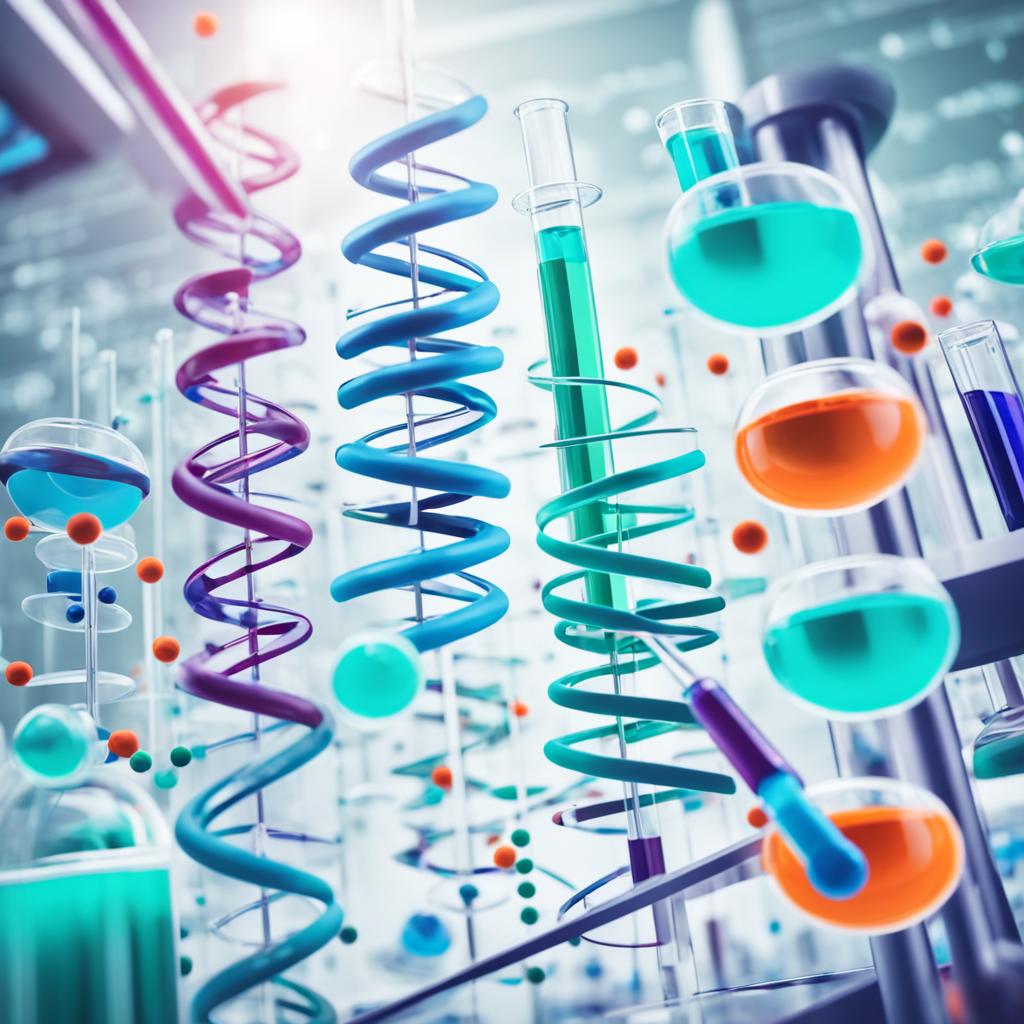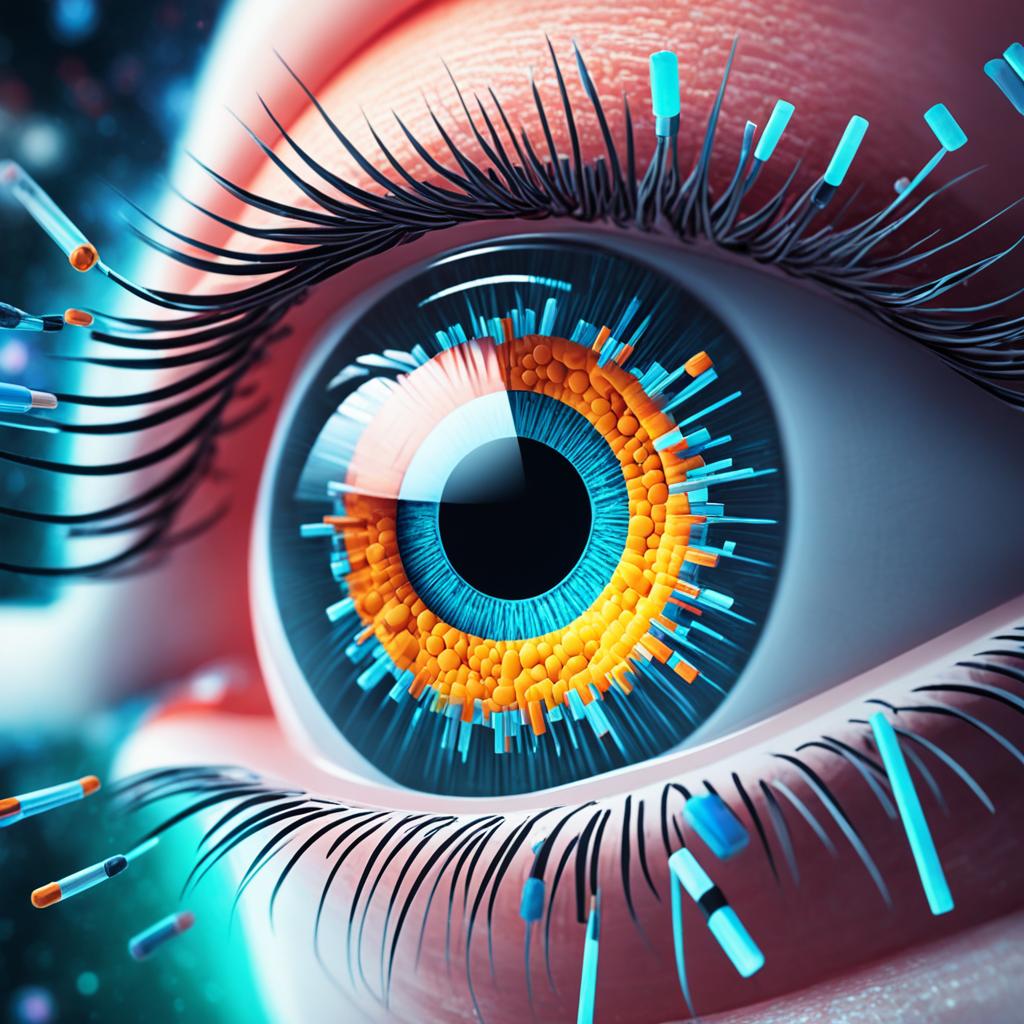The incredible discovery of CRISPR-Cas9 won the 2020 Nobel Prize in Chemistry. It changed biotechnology and medicine forever. Thanks to scientists Jennifer Doudna and Emmanuelle Charpentier, we have a powerful gene-editing tool. This tool can change healthcare and fight many genetic diseases. The Nobel Committee praised CRISPR for its ability to turn the “dream of curing inherited disease” into reality.
CRISPR goes beyond medicine. It’s also helping in agriculture, cleaning the environment, and making better antibiotics. The field of genetic engineering keeps growing. CRISPR’s role in our lives will keep getting bigger. It’s bringing in a new phase of medical progress and solutions for global problems.
Introduction to CRISPR and Gene Editing
The world of genetic engineering is changing fast with the birth of CRISPR technology. Short for Clustered Regularly Interspaced Short Palindromic Repeats, CRISPR is a cutting-edge gene editing tool. It’s finding new ways to fight genetic diseases and pushing the limits of biotechnology.
What is CRISPR?
CRISPR is a natural shield bacteria and archaea use against viruses. This system includes the CRISPR-Cas9 process. It’s like a molecular scissor, pinpointing and cutting specific DNA. Thanks to this, we can now edit genes with impressive accuracy, altering, adding, or removing genetic material.
The Discovery of CRISPR-Cas9
Jennifer Doudna and Emmanuelle Charpentier together found the CRISPR-Cas9 system for gene editing. In 2013, they shared their breakthrough study. It changed the biotech landscape, making genetic engineering faster, cheaper, and more precise than before. The CRISPR-Cas9 system has since become a key player, not only in medicine but also in many other areas.


“The discovery of CRISPR-Cas9 has transformed genome editing, allowing researchers to precisely target and modify DNA sequences with unparalleled efficiency.” – Dr. Jennifer Doudna, co-inventor of CRISPR technology
CRISPR-Cas9 is quickly being adopted for genetic studies worldwide. Its uses range from curing genetic illnesses to creating better cancer treatments. As we dive deeper into its potential, CRISPR’s future in changing medicine and agriculture looks very promising.
The Potential of CRISPR in Medicine
CRISPR is a groundbreaking gene-editing tool that is changing the medical world. It helps tackle genetic diseases and develop new ways to fight cancer. This technology has endless potential in medicine.
Treating Genetic Disorders
With CRISPR/Cas9, we can ‘edit’ DNA, like fixing a typo in a document. It can turn off bad genes, remove or insert DNA to help with diseases like Duchenne muscular dystrophy. This ability to precisely edit genes makes CRISPR very useful in treating genetic illnesses.
Cancer Therapies
CRISPR/Cas9 isn’t just for genetic diseases. It’s also speeding up cancer research by finding key genes. This can lead to new treatments across many types of cancer. Technologies like CRISPR are already showing great results in early cancer treatments, making them very promising.
CRISPR has changed how we think about treating genetic issues and fighting cancer. It offers new paths to study and treat various diseases. As scientists continue their work, there’s a lot more we can do with CRISPR in medicine.
Clinical Trials and CRISPR Applications
CRISPR technology is showing great promise in clinical trials. It’s being used to target different genetic disorders. Sickle cell disease and beta thalassemia are two blood disorders it’s focusing on.
Sickle Cell Disease and Beta Thalassemia
With CRISPR, scientists are editing a particular gene. This edit helps patients make more healthy fetal hemoglobin. The goal is to replace the unhealthy adult hemoglobin. This early method is improving patients’ lives, reducing their health issues.
Casgevy has been a breakthrough. It got the green light for SCD and TDT treatment in late 2023. In trials, most TDT patients and nearly all SCD patients saw major benefits from the treatment.
There are more CRISPR treatments in the works. Editas Medicine and Beam Therapeutics are working on their own approaches. Plus, a UC Consortium is planning a study for early 2025 to directly fix the SCD mutation.
The outcomes of these CRISPR clinical trials are truly exciting. They are giving real hope for the future of treating complex diseases through gene editing.


CRISPR and Vision Loss
CRISPR is changing how we see medicine. It brings hope for people losing their sight. It’s especially looked at for rare eye conditions like Leber’s Congenital Amaurosis (LCA).
Leber’s Congenital Amaurosis
At Oregon Health & Science University, the first in-body CRISPR work happened. It targeted a gene change linked to LCA. This might lead to better vision by allowing cells to make needed proteins.
The first results are encouraging. The method was safe and some patients saw better. About 79% improved. Out of them, 43% felt their life quality was better. Also, 29% could see objects and letters on a chart.
This step shows how gene editing could help with eyesight loss. With over 2.2 billion people having eye issues, this tech’s potential is big. It might really change many lives for the better.


Research on CRISPR for eyesight keeps going. The goal is to help more with genetic eye problems see again. As technology grows, so does the chance to fix these issues.
Biotechnology: CRISPR’s Impact on Cancer Treatment
The CRISPR gene-editing tool is changing how we fight cancer. Scientists use CRISPR to improve immune cells. This helps them fight cancer cells better.
One example is the work at the University of Pennsylvania. There, researchers used CRISPR to upgrade T-cells. These are immune cells. They made T-cells better at killing cancer by changing their genes.
This work is called CAR-T cell therapy. It’s a big step forward in CRISPR cancer treatments.
The power to edit genes precisely is key. It lets us make immune cells that can spot and destroy cancer. This could mean better outcomes for cancer patients.
| Key Advancements in CRISPR Cancer Therapies | Impact on Cancer Treatment |
|---|---|
| CRISPR-modified immune cells with enhanced proliferation and potency | Improved targeting and elimination of cancer cells |
| Ability to precisely edit genes in CRISPR-modified immune cells | Development of targeted and personalized cancer therapies |
| Rapid expansion of CRISPR system variants for diverse genome editing applications | Broadening the capabilities of CRISPR in cancer research and treatment |
CRISPR shows great promise in treating cancer. As we improve this technology, we could see even better CRISPR cancer therapies. This could lead to better outcomes for people with cancer.


The Ethics of CRISPR and Gene Editing
CRISPR technology is making big strides. But, it raises many ethical questions. One key issue is if we should edit genes in babies before they’re born. This is called germline editing. It has led to heated discussions about the rightness and possible bad outcomes of such actions.
Germline Editing and Designer Babies
Some people think editing genes in babies could stop serious diseases or make them better in some way. An example is how CRISPR helped those with sickle cell disease and beta thalassemia in a study. It fixed the genes that caused their health problems.
The problem is that editing genes in babies raises a lot of concerns, and no one can fully agree on what’s right and wrong. This has led to a push for rules and laws on how and when to use this technology.
In 2018, a scientist in China, He Jiankui, claimed he changed the genes of two babies before birth. The world was very upset by this news. Many worry about the risks, like creating a gap between those who can afford gene editing and the rest of society.
We need to pay close attention to how we use gene editing. Leaders in bioethics, like Robert Truog and George Q. Daley from Harvard, say we must set up clear rules. This is to make sure CRISPR is used correctly and fairly by everyone.


The debate on CRISPR’s ethics isn’t over. More talks are needed as the technology grows. We must keep thinking about the benefits and downsides of using it. Then, we can create rules that are right for everyone.
Regulatory Oversight and Safety Concerns
CRISPR technology keeps the scientific world excited. But, concerns about safety are growing. The U.S. Food and Drug Administration (FDA) is on it, offering guidelines on gene editing.
They see the big chance CRISPR has to help. But, they also remind us of the unknown risks like changes we didn’t plan and long-term effects. They said we have to watch very closely, especially as editing genes inside the body gets more real.
FDA Guidelines on Gene Editing
Staying on top of CRISPR’s safety and ethical use is vital. The FDA thinks careful looking and watching can help control the risks.
They have rules from 1986 that got updated in 2017. These help them, the EPA, and the USDA watch over new biotech products.
In 2022, President Biden made a big move. He ordered the U.S. to put more into biotechnology. This shows the U.S. cares about safety, laws, and other important issues in growing these techs.
“Biotechnology advancements need to prioritize safety, security, and ethical, legal, and social implications (ELSI) in development, dissemination, use, and governance.”
The work on CRISPR regulations, FDA guidelines, and ensuring gene editing safety is key for the future. We all – regulators, tech developers, and the public – need to work together. This way, we can make sure CRISPR moves ahead safely and responsibly.
The Future of CRISPR and Gene Therapy
The future looks very bright for CRISPR and gene therapy. This cutting-edge technology is making huge strides in medicine. It’s being used to tackle a wide array of genetic disorders.
Everything from rare diseases to cancer is being examined. As these therapies move through trials and approvals, they could change how we deal with genetic diseases.
CRISPR gives the power to edit genes with extreme precision. This brings hope for not just new, but personalized treatments. This could really lift the outcomes and life quality for patients. Back in 2015, the World Economic Forum saw CRISPR’s potential. Now, in 2020, it won a Nobel Prize. This all shows the huge changes it might bring.
CRISPR’s role in gene therapy keeps growing. Just in January 2022, the US FDA gave the green light to a rapid COVID-19 test. This test can check thousands of samples quickly, thanks to CRISPR.
CRISPR has even removed HIV from cells in a major breakthrough. This offers big hope for future HIV treatments. The use of CRISPR in clinical trials for diseases like blindness and cancer is moving fast. It’s showing real promise.
“CRISPR has the potential to be a game-changer in the field of medicine, enabling us to tackle genetic-based diseases in ways we never thought possible. As the technology continues to evolve, the future of CRISPR is truly exciting.”
CRISPR is changing everything from diagnostics to treatment. Its impact is broad and deep. With more research and effort, CRISPR and gene therapy could totally change how we deal with genetic illnesses.
Ongoing CRISPR Research and Development
CRISPR technology is making scientists, lawyers, and investors very busy. They are working to make gene editing better and claim ownership. In Cambridge, Massachusetts, researcher Feng Zhang leads these efforts at the Broad Institute. His work has led to biotech companies that are now worth over $4.7 billion.
Intellectual Property and Commercialization
There are still debates over who owns CRISPR, but this hasn’t stopped the progress. Companies and researchers are moving quickly to use this powerful technology. They aim to apply it in the medical field. This mix of new science, who owns it, and making money will likely decide the future course of CRISPR research.
Teams have found a faster way to study muscles using CRISPR tools. They’ve also made AsCas12f, a gene-editing tool, which could treat genetic diseases better. Plus, they’ve figured out how to better use a system to fight viruses, turning it into a more powerful weapon.
NICER, a new gene-editing method, is making less mistakes than older methods. A study on monkeys showed promise by curing a virus with one treatment, by using CRISPR. This highlights CRISPR’s bright future in gene therapy.
All these developments show that people are hard at work on CRISPR intellectual property and research. The goal is to make CRISPR even better for new medical solutions and treatments.
Challenges and Limitations of CRISPR Technology
CRISPR has changed genetic engineering but has some issues. One big worry is “off-target” effects. This happens when CRISPR changes the wrong DNA, possibly causing harm.
The off-target effects are well studied. They can happen when CRISPR edits DNA that looks like the target but isn’t exactly it. This is risky in medicines, as wrong changes could harm patients.
The FDA and others say we must watch CRISPR closely, especially for gene editing inside the body. Making designer babies brings up tough ethical questions. We need clear rules to ensure CRISPR is used fairly and safely.
To make CRISPR better for everyone, we must fix these issues. This means making CRISPR edit only the right DNA and keeping it safe. Ethical and rule challenges must also be faced.
“The fear of gene drive is a significant risk associated with CRISPR, as manipulated genes could be transferred to other organisms and potentially lead to uncontrollable mutations in the environment.”
Conclusion
CRISPR and genetic engineering may change medicine as we know it. It’s a powerful tool created by Doudna and Charpentier. It allows us to treat genetic disorders, make new cancer therapies, and help with many health problems. Trials for diseases like sickle cell disease are underway, and the results look hopeful.
But CRISPR also brings up major ethical and safety concerns. It needs careful monitoring and clear rules. As biotechnology grows, CRISPR’s impact on medicine will be huge. It will change how we tackle genetic diseases.
The technology is advancing fast, and many new biotech products are being made. We need a strong system to keep them safe and trustworthy. People must see them as safe and beneficial.
It’s really important for scientists, leaders, and the public to talk openly. They need to discuss the facts and ethical dilemmas around genetic engineering. Open discussions in local meetings, media talks, and referendums can help. They ensure that using CRISPR stays in line with what society wants and cares about.
Source Links
- https://www.scientificamerican.com/custom-media/biggest-questions-in-science/next-gen-crispr-and-the-future-of-gene-editing/
- https://cellculturecompany.com/unlocking-the-future-of-medicine-genetic-engineering-and-crispr-research/
- https://sitn.hms.harvard.edu/flash/2014/crispr-a-game-changing-genetic-engineering-technique/
- https://medlineplus.gov/genetics/understanding/genomicresearch/genomeediting/
- https://www.bio-rad.com/en-us/applications-technologies/crispr-cas-gene-editing-teaching-resources?ID=Q58I0DWDLBV5
- https://www.ncbi.nlm.nih.gov/books/NBK447276/
- https://www.mckinsey.com/industries/life-sciences/our-insights/realizing-the-potential-of-crispr
- https://www.frontiersin.org/journals/cell-and-developmental-biology/articles/10.3389/fcell.2021.699597/full
- https://innovativegenomics.org/crisprpedia/crispr-in-medicine/
- https://link.springer.com/article/10.1007/s12033-023-00724-z
- https://innovativegenomics.org/news/crispr-clinical-trials-2024/
- https://innovativegenomics.org/news/crispr-clinical-trials-2023/
- https://www.umassmed.edu/news/news-archives/2020/06/gene-therapy-and-crispr-strategies-for-curing-blindness/
- https://www.ncbi.nlm.nih.gov/pmc/articles/PMC9569777/
- https://www.labiotech.eu/in-depth/crispr-promising-path-to-treating-blindness/
- https://www.cancer.gov/news-events/cancer-currents-blog/2020/crispr-cancer-research-treatment
- https://www.ncbi.nlm.nih.gov/pmc/articles/PMC9955208/
- https://www.nature.com/articles/s41568-022-00441-w
- https://news.harvard.edu/gazette/story/2019/01/perspectives-on-gene-editing/
- https://www.ncbi.nlm.nih.gov/pmc/articles/PMC9793437/
- https://med.nyu.edu/departments-institutes/population-health/divisions-sections-centers/medical-ethics/sites/default/files/medical-ethics-crispr-and-genetic-modification.pdf
- https://www.epa.gov/newsreleases/epa-fda-and-usda-issues-updates-joint-regulatory-plan-biotechnology
- https://www.usda.gov/topics/biotechnology/how-federal-government-regulates-biotech-plants
- https://www.ncbi.nlm.nih.gov/pmc/articles/PMC9873990/
- https://www.weforum.org/agenda/2024/04/crispr-gene-editing-better-world/
- https://www.genengnews.com/sponsored/what-lies-ahead-shaping-the-future-of-cell-and-gene-therapy/
- https://www.biopharmadive.com/news/crispr-biotech-gene-editing-broad-berkeley-history/695401/
- https://www.sciencedaily.com/news/plants_animals/crispr_gene_editing/
- https://www.broadinstitute.org/what-broad/areas-focus/project-spotlight/crispr-timeline
- https://www.nature.com/articles/s41392-023-01309-7
- https://insights.som.yale.edu/insights/is-crispr-worth-the-risk
- https://www.ncbi.nlm.nih.gov/pmc/articles/PMC7427626/
- https://www.idtdna.com/pages/community/blog/post/crispr-cas9-what-are-the-10-pros-and-7-cons
- https://www.justice.gc.ca/eng/rp-pr/csj-sjc/jsp-sjp/rp02_1-dr02_1/p6.html
- https://www.ncbi.nlm.nih.gov/books/NBK442201/
- https://www.ncbi.nlm.nih.gov/books/NBK222047/
